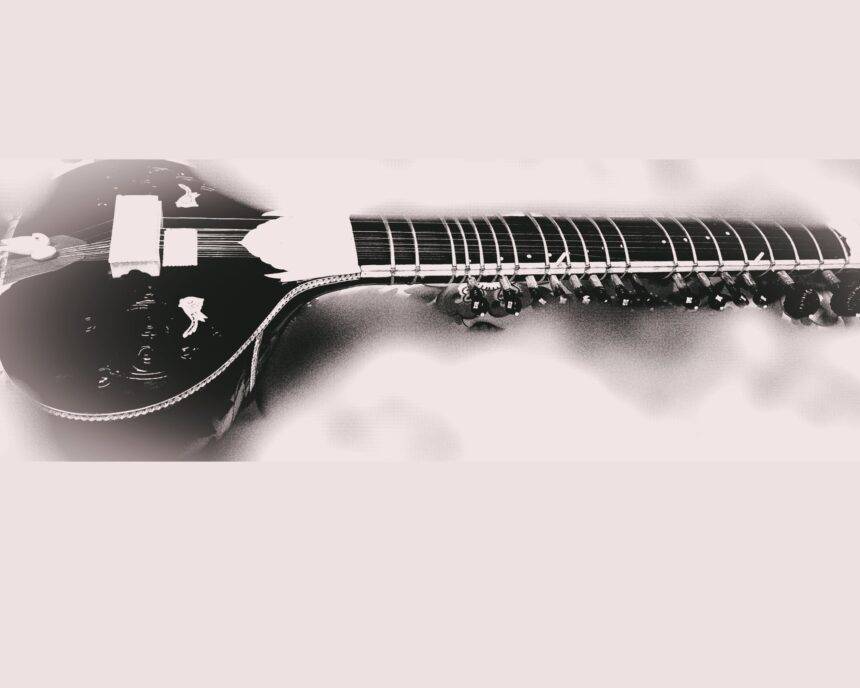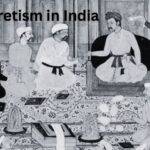I never went into detail on the sitar’s performance structure because I was afraid it would be too complex for readers who aren’t musicians. Nonetheless, I believe that it’s crucial and that the earlier works need to have established a framework with which the readers may identify. Maybe a few readers would have been interested in this as well. As a result, I decided to examine them phase-by-phase in the next chapters. So, let’s start today with Alap.
Alap, the soulful and meditative opening segment of performance in Hindustani classical music, is a canvas on which the artist paints the intricate hues of emotion and melody. Derived from the Sanskrit word ‘alapa,’ meaning “to speak” or “to converse,” Alap is a musical conversation that transcends words. This unhurried and introspective phase allows the musician to establish the raga, the fundamental framework of Indian classical music. The artist commences with slow, graceful phrases, exploring the melodic contours of the chosen raga. The absence of rhythm during Alap liberates the performer to focus solely on the melodic landscape, unveiling the raga’s essence through a series of ascending and descending movements. The Alap is not just a technical exposition; it’s a spiritual journey where the artist delves into the emotional landscape of the raga.
Alap, with its slow pace and contemplative nature, serves as a gateway to a meditative realm within Hindustani classical music. Beyond the technicalities of melody and rhythm, Alap becomes a spiritual journey for both the artist and the listener, inviting them to connect with deeper dimensions of emotion and transcendence. In the meditative aspect of Alap, time seems to stretch and fold, creating a space where the artist can dwell in each note, exploring its resonance and significance. The absence of a rigid rhythmic structure allows for a profound sense of stillness, enabling the musician to delve into a state of deep concentration and introspection. This meditative quality is not just a performance technique; it is a conscious choice to embrace the present moment and allow the music to unfold organically. The spirituality embedded in Alap is rooted in the tradition of raga, where each raga is associated with a particular mood, emotion, or even a time of day. As the artist navigates through the melodic landscape, they tap into the spiritual essence of the raga, channeling the emotions and stories woven into its fabric. The meditative exploration becomes a spiritual dialogue, a communion with the divine through the language of music. Microtonal nuances, carefully crafted phrases, and the deliberate use of space contribute to the meditative quality of Alap. The artist’s focus extends beyond technical virtuosity to a deep listening, a meditative attentiveness to the unfolding tapestry of sound. Each note becomes a mantra, and the artist, a seeker, navigates the sonic labyrinth with reverence and mindfulness.
For the listener, the meditative aspect of Alap offers a contemplative space to experience the emotive power of music. It transcends the ordinary, inviting the audience to a shared journey of introspection. In this meditative state, the boundaries between performer and listener blur, creating a collective space where both are immersed in the spiritual resonance of the raga. In the context of Hindustani classical music, Alap is not merely a performance; it is a spiritual practice, a form of meditation that transcends the mundane. It is a celebration of the sacred within sound, an offering that seeks to connect with something larger than the self. Through the meditative exploration of Alap, the artist and the audience embark on a shared spiritual voyage, where the boundaries of the material world dissolve, and the soulful vibrations of music resonate with the eternal.
In Hindustani classical music, the Alap takes on diverse expressions across different genres, offering a nuanced and captivating experience for both performers and listeners. In vocal music, the singer employs the human voice as a profound instrument of expression, gradually unfolding the raga with emotive power. Instrumentalists, wielding sitar, sarod, or flute, bring a unique instrumental vocabulary to the Alap, emphasizing abstract exploration through pitch, tone, and timbre. The Dhrupad style, known for its austere approach, infuses the Alap with gravity and depth, unfolding the raga methodically. In contrast, the Khayal style explores a wider range of melodic flourishes, incorporating intricate taans and showcasing technical prowess. Lighter genres like Thumri and Dadra integrate Alap more subtly, setting the mood before delving into lyrical expressions. Across these genres, Alap remains a foundational and versatile element, adapting to the unique characteristics of each style and enriching the aesthetic tapestry of Hindustani classical music.
In the context of the sitar, the Alap is a mesmerizing exploration of the raga that showcases the instrument’s expressive capabilities and the artist’s skillful technique. The sitarist embarks on a gradual and contemplative journey, unfurling the melodic nuances of the chosen raga without the constraints of rhythm. The Alap on the sitar begins with slow, deliberate phrases that establish the tonal character of the raga. The artist utilizes a combination of slides (meend), hammer-ons (murki), and intricate ornamentations to bring out the unique identity of the raga. The absence of rhythmic accompaniment allows for a deep focus on the resonant tones and subtle microtonal variations that define the sitar’s sound.
As the Alap progresses, the sitarist introduces dynamic contrasts, exploring the instrument’s full sonic range. The Alap on the sitar is not merely a technical display but a spiritual journey, where each note becomes a vessel for emotional expression. The meditative quality of the Alap is particularly pronounced on the sitar, as the artist delves into the introspective aspects of the raga. The slow and contemplative nature of the Alap allows the sitarist to create a sonic atmosphere that invites the listener into a reflective state, transcending the boundaries of time and space. In the hands of a skilled sitar player, the Alap becomes a dialogue between the artist, the instrument, and the essence of the raga. It is a moment of connection with the deep tradition of Hindustani classical music, where the sitarist channels the spirit of the raga, infusing each phrase with emotion and spirituality. The Alap on the sitar, with its intricate melodic explorations and evocative tonalities, is a captivating prelude that sets the stage for the rhythmic and dynamic elements to follow in a Hindustani classical performance.
The Alap in sitar music unfolds through distinct stages, each contributing to the gradual and immersive exploration of the chosen raga. Commencing with the Vilambit (slow) Alap, the sitarist introduces deliberate and unhurried phrases, setting a contemplative mood and establishing the fundamental notes of the raga. Transitioning into the Madhya (medium) Alap, the tempo gently increases, allowing for a deeper exploration of the raga’s scale and showcasing the artist’s technical proficiency. The Drut (fast) Alap marks the culmination, with the tempo reaching its peak and the sitarist employing faster, complex phrases that demonstrate virtuosity and mastery. This final stage intensifies the emotional and sonic impact of the Alap, leading seamlessly into the Jor and Jhala sections, where rhythmic elements are introduced. Throughout these stages, the sitarist employs a diverse array of techniques, such as meend (slides), gamak (ornamentation), and taans (fast runs), creating a spiritual and emotive journey that invites both the performer and the listener to delve into the intricate beauty of the raga.
The Alap encompasses a nuanced exploration, featuring various stylistic elements or “angs’ ‘ that contribute to its intricate beauty. Swar Vistaar involves the elaborate expansion of specific notes, emphasizing their inherent beauty, while meend or slides create a seamless glide between tones, adding expressiveness. Akar, the vocal articulation of sounds, and alankar, ornamental techniques like gamak and kan, enhance the aesthetic appeal. Jod connects distinct melodic phrases, and layakari introduces subtle rhythmic play. Taans, fast runs, showcase technical virtuosity. The pursuit of sama or balance ensures a cohesive and well-paced Alap, where each element harmoniously contributes to the rich structure of the sitar performance. Ultimately, the specific interpretation of these elements can vary among performers, offering a diverse and dynamic landscape within the tradition of Hindustani classical music.







